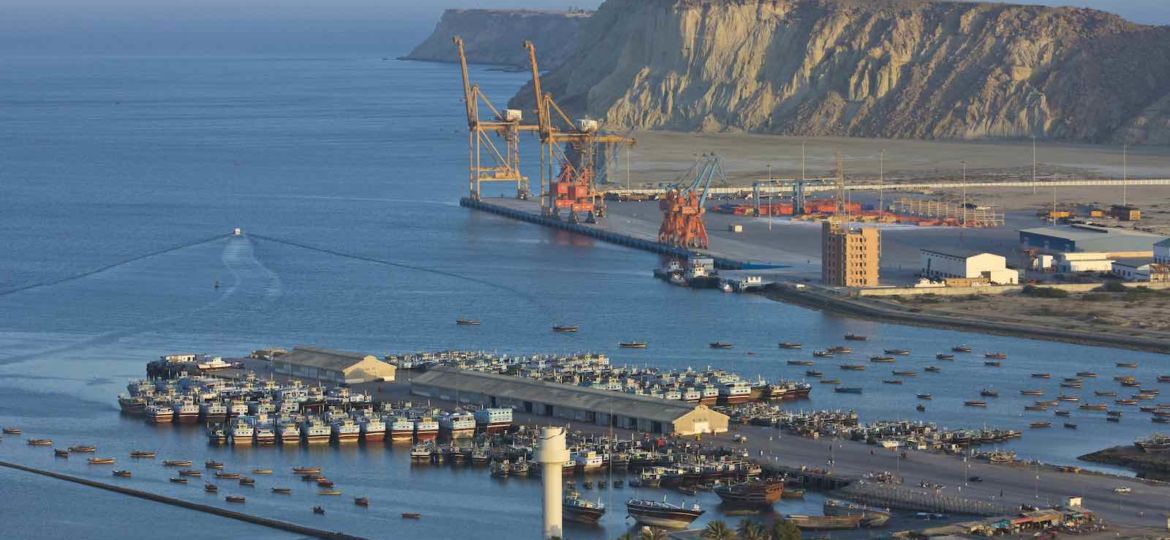BY: Dr. Muhammad Akram Zaheer
 Gwadar is a newly built warm water seaport in the southwest of Pakistan on the shores of the Arabian Sea along a 600 km-long coastline. It is a God-gifted natural deep sea port unlike the contemporary ports of Iran and Dubai, and has the capacity to have 88 berths and ability to anchor a mothership of 1,00,000-2,00,000 DWT. It is located at the mouth of the Persian Gulf and 624 nautical km away to its west is the Strait of Hormuz. Strategically, it is situated in the midst of three important regions: the Middle East, South Asia, and Central Asia. It is only 1500 km away from Turkmenistan, Uzbekistan & Tajikistan. It is also surrounded by a third of the world’s oil resources.
Gwadar is a newly built warm water seaport in the southwest of Pakistan on the shores of the Arabian Sea along a 600 km-long coastline. It is a God-gifted natural deep sea port unlike the contemporary ports of Iran and Dubai, and has the capacity to have 88 berths and ability to anchor a mothership of 1,00,000-2,00,000 DWT. It is located at the mouth of the Persian Gulf and 624 nautical km away to its west is the Strait of Hormuz. Strategically, it is situated in the midst of three important regions: the Middle East, South Asia, and Central Asia. It is only 1500 km away from Turkmenistan, Uzbekistan & Tajikistan. It is also surrounded by a third of the world’s oil resources.
Historically, it was under the colonial occupation of Oman and then transferred to Pakistan on 8 September 1958. Then in 1977, it was incorporated as a community district of Baluchistan. The program of the construction of Gwadar seaport was launched for the first time in 1964, and then after three decades, it resumed once more in 2000. In March 2002, China started support on the condition of transferring sovereignty guarantees of the port to China. China provided 198 million dollars for the first phase that was completed in 2006. In 2007, the port was leased for 40 years to the Port of Singapore Authority. The PSA could not make any positive development for the Gwadar Port. Then it was handed over to the China Overseas Port Holding Limited in February 2014. This is another milestone in Chinese-Pakistani relations and economic commitment. The construction of an additional nine berths, a bulk cargo terminal, grain terminal, and two oil terminals are included in the 2nd phase and investments of 600 million dollars are estimated.
Due to its large population and the rapidly growing economy, China is a great consumer of energy. It fulfills its need from the Malaccan Strait and Persian Gulf through the longest sea route across the Indian Ocean. The Chinese think that the Indian Ocean route is insecure and that this increases their energy dependency. Pakistan’s geostrategic position enables China to create new economic corridors and connectivity with regional states. It will also decrease the energy flows of China in the Indian Ocean. The China-Pakistan Economic Corridor is a 2000 km route that will link Gwadar to Kashgar. The project was recognized in May 2013 and imagined the investment of 12 billion dollars.China is focusing on redevelopment of internal structure of roads and railway lines sea transportation, construction of oil gas pipe line, lay optical fiber cabal and alternate electric resources.
The importance of Gwadar seaport depends upon its development into a potential economic hub. Gwadar seaport lies at the heart of the Sino-Pakistan partnership and is its litmus test. Former President Musharaf in 2002 said about Gwadar, “If we see this whole region, it is like a funnel. The top of the funnel is this wide area of Central Asia and also China’s western region. And this funnel gets narrowed on through Afghanistan and Pakistan and the end of this funnel is Gwadar port. So this funnel, futuristically, is the economic funnel of this whole region.”This plan carries an economic prosperity attractive to multiple stakeholders from the region.
China is looking for new trade and energy corridors from its western region to the Arabian Sea. If the real potential is utilized, then it can be prove to be a cornerstone of economic development and help to improve the troubles of the people of Balochistan and other parts of the country. The present crippled economy of the country can improve in a short span of time if the project is successfully implemented.
The contemporary ports of the region do not have the advances of the Gwadar seaport, which can bring together world business and trade. The Central Asian Republics (CARs) can have a shorter route to global markets due to Gwadar’s geostrategic location, and at the same time, the development countries can also access their natural capital possessions and markets because Gwadar is only 1500 km from Turkmenistan, Uzbekistan & Tajikistan. Secondly, East Africa is very close to Gwadar, and thus, also China and the CARs. The natural resources of Africa can be easily shipped to Gwadar, and after value-added additions, can then be reshipped other global consumer markets. Nearby India and China account for almost half of the world’s population, and Gwadar can facilitate their trade with the CARs and Africa. The port can also provide transshipment services as well as trade transit considering that Dubai earns billions of dollars from this business yet is 700 km further away from Gwadar and its partners must first pass through the narrow Strait of Hormuz to access it.
The ideal location of the Gwadar seaport and coastal belt significantly enables Pakistan to keep an eye on the oil shipped out of the Middle East. The products of oil refineries and LNG plants can be shipped or piped to any country of the globe with short consumption of energy. The transit route to the CARs and China would be dependent on Gwadar. Further, Pakistan can be able to develop understanding with India because the western part of India will also prefer to have transit trade through Gwadar as it lies at a shorter distance than Indian ports.
The Gwadar seaport requires less maintenance cost as compared to other ports since it’s a natural deep sea port. The project not only connects China and Pakistan, but it provides opportunities for business and jobs for the Pakistani and Chinese people and also for their neighboring countries. This port can attract trade and business like a magnet due to cheap sea transportation. Similarly, it has the potential to address and decrease the unemployment of Baluchistan and other parts of Pakistan with economic development in the coming years. The opportunities for business and jobs will stretch from Gwadar to the Khunjerab Pass and thus immensely benefit all of Pakistan’s provinces. The running of millions of vehicles on the route from Gwadar to Khunjrab would resemble the ancient Silk Road caravans that carried silk along the Golden Route, albeit trading many more different products in the present day.
The construction of a road-rail network from Gwadar to Kashgar is an enormous task and financially sound but not impossible. China’s technological expertise, experience, and desire to expand trade and business routes from its western region to the rest of the global market through Gwadar can make this dream a reality without Pakistan having to entirely finance this vision. Pakistan should be on board to provide security to the Chinese and other investors and satisfy their all queries and worries, which should be sincerely addressed at all levels. Similarly, by taking the regional and international powers into confidence for the commercial use of the port, the economic interdependence at the country at the regional and international levels will automatically guarantee security to all actors along with evolving a conducive business environment. The project of the China-Pakistan Economic Corridor is becoming a new vista for China-Pakistan relations. Both countries can increase cultural, economic, and strategic relations and people-to-people contact, which will bring regional stability and peace.
The Strategic Prospect of Gwadar













